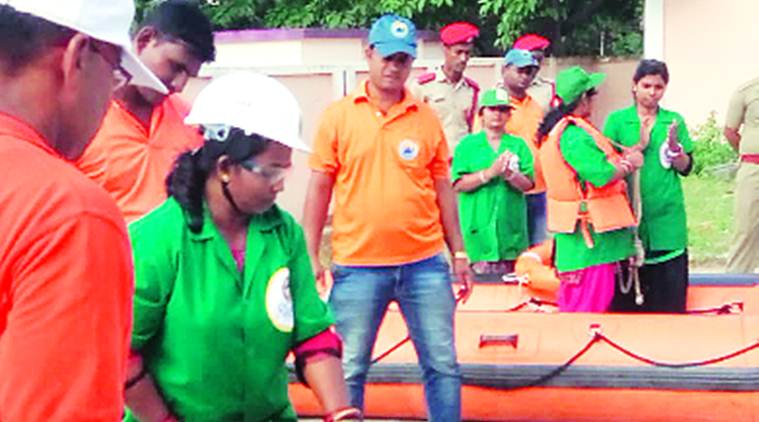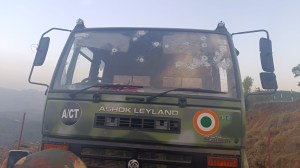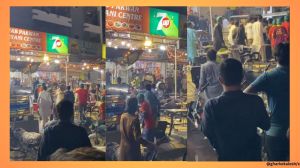- India
- International
In cyclone-prone Odisha dist, women learn to save themselves, others
As part of the training session, which roughly coincides with the 20th anniversary of the 1999 Super Cyclone that killed nearly 10,000 people in the state, women are given interactive and intensive training by local ODRAF members, police and the fire and health departments.
 At a training programme in Chattrapur, Odisha. (Express Photo)
At a training programme in Chattrapur, Odisha. (Express Photo)
Let’s Assume there is a cyclone, and you later see a man lying on the ground with a fractured leg. How do you move him?” asks trainer Bijay Kumar. Some among the group of women, who sit on chairs facing Kumar, attempt a few answers. “Do not pull him by his legs or arms. I will show you how to make a stretcher and how you can roll him on to it. It’s easy… the stretcher can be made using household items,” he continues.
Battered by three cyclones in five years — Phailin in 2013, Hudhud in 2014 and Titli in 2018 — south coastal Odisha’s Ganjam district is taking the next step in disaster management through Swayamsiddha, a project that aims to impart rural women with life-saving skills and information in the event of a natural calamity.
Kumar, a member of the Odisha Disaster Rapid Action Force (ODRAF), is training a batch of 50 women — all of them dressed in Swayamsiddha’s special uniform, green coats and caps — who have assembled at the Old Collectorate Building at Chattrapur block in Ganjam. As part of the training session, which roughly coincides with the 20th anniversary of the 1999 Super Cyclone that killed nearly 10,000 people in the state, women are given interactive and intensive training by local ODRAF members, police and the fire and health departments.
Express Explained | Why Cyclone Kyarr is unlikely to hit India’s west coast
“Swayamsiddha means self-sufficiency”, says Ganjam Collector Vijay Amrut Kulange, who designed the initiative with other officers of the district administration. “We will be training 5,000 women across 23 blocks in the district. In this district that’s vulnerable to disasters, we will try to turn rural women from the rescued to the rescuers.”

The training programme is also focusing on “persuasive evacuation”. During the evacuation in Ganjam ahead of May’s cyclonic storm Fani, a photograph of Berhampur SP Pinak Mishra had gone viral, in which he was seen persuading people with folded hands to leave their homes. But many had stayed back, claiming they were more worried about possible break-ins if they abandoned their homes than the storm itself.
“Police and district administration had a tough time evacuating people, especially pregnant and older women. There were other problems too — in some cases, women were uncomfortable being carried by men,” says Bharati Behera, another district official. “We are training women to evacuate women because as members of the community, they can be more persuasive.”
Also Read | Cyclone Fani: Centre nod to Rs 3,338 crore for Odisha
Behera says the training will also focus on how the disabled, the elderly and pregnant women are to be carried. Trainer Bijay calls on two women trainees to carry another from the group — “slide each of her arms around each of your necks, keep one hand each on her lower waist…,” he tells the women.
Officials in the district administration say the programme, which has trained two batches so far, is so popular that not a single woman misses the session. Women attending the training are provided with lunch and take back a colourful 35-page booklet with information printed in Odia.
While the programme has received funds from the Odisha Livelihood Mission, Odisha State Disaster Management Authority and Mission Shakti, ODRAF had proposed to impart the training for free. “It is an honour for us to do this. The women look up to us. Anyway, we are free when there is no disaster to battle,” says Kumar.
As part of the training exercise, the women are also taught how to start a generator, operate an electric chain saw to cut trees, and use household items such as an old scooter tyre tube to stay afloat. “If trained correctly, people need not depend on the government for everything in the aftermath of a natural calamity,” says Kulange.
Through Swayamsiddha, the district health and fire department units are also training women to manage other everyday dangers: dog bites, snakebites, and extinguishing kitchen fires at home. Police are also training women in basic self-defence skills.
“This training has changed our world,” says Bobby Behera, 35, who is attending the training at the Old Collectorate Building in Chattrapur. “We can help ourselves and our families rather than weeping when the storms and floods hit us.”
According to the state government, around 11 lakh people were evacuated from around eight coastal districts ahead of Fani, which ravaged the coast, especially Puri, in May. According to a government-endorsed report, 64 people died during and immediately after. In Cyclone Titli, the death toll was around 60, while lakhs of people were affected in Gajapati and Ganjam districts. The death toll in Phailin’s was around 40. While Hudhud did not claim many lives, it destroyed property in Ganjam and Gajapati.
Buzzing Now
May 04: Latest News
- 01
- 02
- 03
- 04
- 05





































